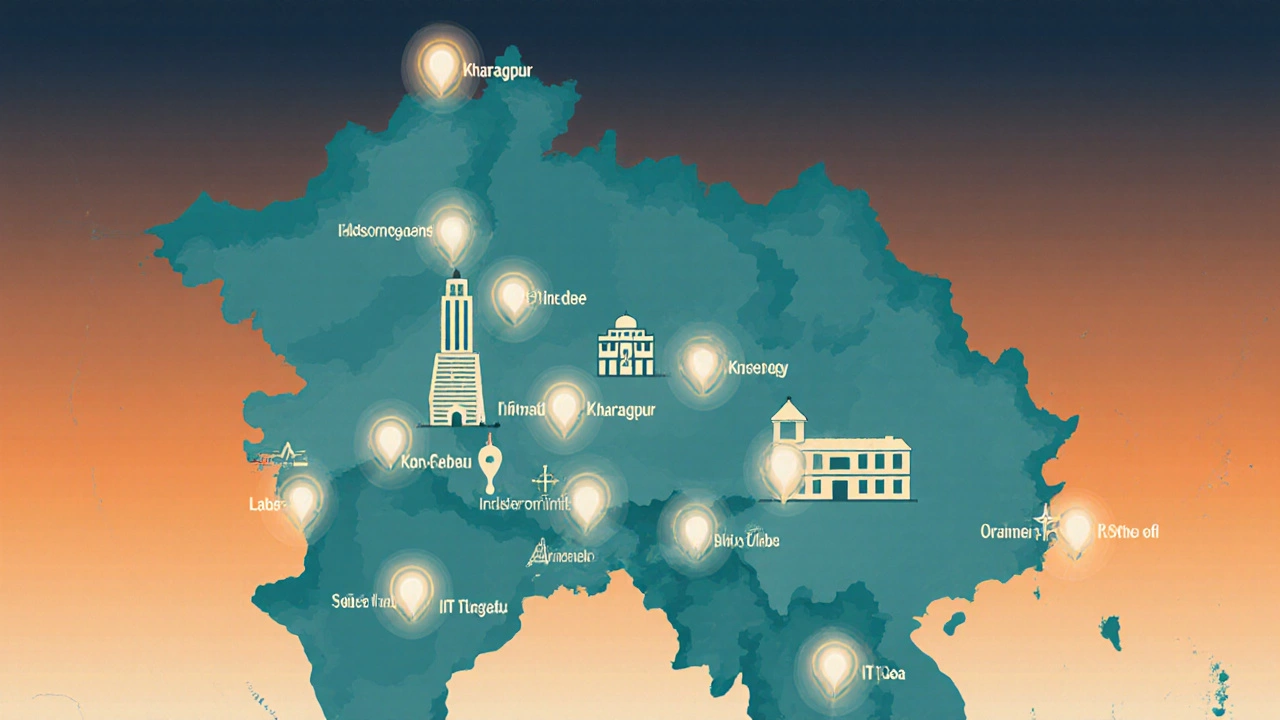IIT Seat Distribution Calculator
IIT Seat Distribution Calculator
Calculate how many seats you could potentially get based on your reservation category and preferred IIT. Total seats for 2025: 16,527
Select a reservation category and/or IIT to see the distribution
Trying to gauge your chances for an IIT seat? Knowing exactly how many slots exist across the country is the first step. Below we unpack the total number of IIT seats for 2025, split the figures by institute, program, and reservation category, and show you where the official data lives.
What counts as an IIT seat?
IIT seats are the individual admission slots offered by each Indian Institute of Technology for the undergraduate B.Tech programs. These slots are allocated after the JEE Advanced the final entrance exam that filters JEE Main qualifiers for IIT admissions and are distributed through the JOSAA Joint Seat Allocation Authority, the platform that runs the counseling and seat allotment process. Every year, the Ministry of Education (formerly MHRD) publishes the official seat matrix, which becomes the basis for JOSAA's online portal.
Total seat count for 2025
For the 2025 intake, the Ministry released a consolidated matrix that totals 16,527 undergraduate seats across all 23 IITs. This number includes regular B.Tech seats, dual‑degree seats, and a small set of seats for diploma holders converting to B.Tech.
Seat distribution by institute
Here's a quick look at how the 16,527 slots are spread across the IITs. The numbers reflect the latest approved intake for each campus.
| IIT | Total Seats |
|---|---|
| IIT Kharagpur | 4,120 |
| IIT Bombay | 1,830 |
| IIT Delhi | 2,050 |
| IIT Madras | 2,300 |
| IIT Kanpur | 2,010 |
| IIT Guwahati | 1,060 |
| IIT Roorkee | 880 |
| IIT Ropar | 540 |
| IIT Bhubaneswar | 540 |
| IIT Gandhinagar | 560 |
| IIT Hyderabad | 800 |
| IIT Indore | 1,080 |
| IIT (BHU) Varanasi | 730 |
| IIT Patna | 620 |
| IIT Jodhpur | 560 |
| IIT Dhanbad (ISI) | 800 |
| IIT Tirupati | 460 |
| IIT Bhilai | 560 |
| IIT Goa | 370 |
| IIT Jammu | 370 |
| IIT Dharwad | 420 |
| IIT Palakkad | 420 |
| IIT Mandi | 310 |
| IIT Varanasi (BHU) (duplicate entry removed) |
These figures add up to the 16,527 total mentioned above. The numbers can shift slightly each year as the Ministry approves new programmes or expands existing ones.

How seats are reserved
Reservation policies affect how the total pool is divided. The seats are allocated across the following categories:
- General category - about 68% of the total.
- OBC‑NCL (Other Backward Classes - Non‑Creamy Layer) - roughly 27%.
- SC (Scheduled Castes) - around 15% of the overall capacity.
- ST (Scheduled Tribes) - near 7%.
- EWS (Economically Weaker Sections) - about 10% of the General seats.
- PIO/NRIs (Persons of Indian Origin / Non‑Resident Indians) - a separate quota of 2% per institute.
- Foreign Nationals - limited seats under the Institute’s International Collaboration Programme.
The exact percentages can vary a bit because each IIT may adjust internal allocations based on lab capacity, faculty strength, and industry tie‑ups.
Where to find the official seat matrix
The most reliable source is the Ministry of Education’s official portal. Look for the "Seat Matrix" PDF under the "IITs" section for the current academic year. The same document is mirrored on the JOSAA website during the counseling window.
Steps to locate it:
- Visit the Ministry’s website and navigate to Higher Education → IITs → Seat Matrix.
- Download the PDF titled "IIT Seat Matrix 2025".
- Open the file; the first page gives the total seat count, while subsequent pages break down each institute and reservation category.
- Cross‑check the numbers on the JOSAA portal (josaa.nic.in) during the counseling schedule; they publish the same matrix for candidate reference.

Trends over the past five years
From 2020 to 2024, the total seat count grew from 13,000 to 15,600, reflecting a steady 5‑6% annual increase. The biggest jumps came from newer IITs like IIT Gandhinagar, IIT Bhilai, and IIT Goa, each adding 150‑300 seats when they opened new departments.
Another notable trend is the rise of dual‑degree programs (B.Tech+M.Tech), which currently account for about 12% of the overall seats. This option allows students to finish both degrees in five years, and IITs have been expanding these slots to meet industry demand for research‑oriented graduates.
How the seat count affects your preparation strategy
Understanding the exact numbers helps you set realistic expectations:
- If you belong to a reserved category, calculate the approximate number of seats you’ll be competing for in each IIT. For example, an OBC‑NCL candidate has roughly 27% of 16,527, which is about 4,460 seats nation‑wide.
- Identify institutes where your preferred branch has higher intake. Mechanical engineering, for instance, has 2,800 slots across all IITs, while newer branches like AI and Data Science have fewer than 350 combined.
- Use the data to prioritize counselling options. Seats in older IITs tend to fill faster, so if you’re aiming for IIT Kharagpur, you might need a higher rank than for a newer IIT with more vacancies.
Bottom line: the more precise your knowledge of seat distribution, the better you can tailor your rank targets and counseling choices.
Frequently Asked Questions
How many total IIT seats are there in 2025?
The official seat matrix lists 16,527 undergraduate seats across all 23 IITs for the 2025 intake.
Where can I download the official seat matrix?
Visit the Ministry of Education’s website, go to the IIT section, and download the PDF titled "IIT Seat Matrix 2025". The same file is also available on the JOSAA portal during counseling.
How are seats divided among reservation categories?
Approximately 68% are General, 27% OBC‑NCL, 15% SC, 7% ST, with an additional 10% of General seats reserved for EWS. Each IIT also sets aside 2% for PIO/NRIs and a few seats for foreign nationals.
Do newer IITs have more seats than older ones?
Newer IITs often have higher per‑branch intake because they are still expanding infrastructure, but total seats can be lower than legacy campuses like Kharagpur or Bombay.
What impact do dual‑degree seats have on the total count?
Dual‑degree seats are included in the overall total. They currently make up about 12% of the 16,527 slots, offering a combined B.Tech+M.Tech pathway.
